| Albalophosaurus Temporal range: Early Cretaceous, ?
| |
|---|---|

| |
| Scientific classification | |
| Domain: | Eukaryota |
| Kingdom: | Animalia |
| Phylum: | Chordata |
| Clade: | Dinosauria |
| Clade: | †Ornithischia |
| Suborder: | †Ceratopsia |
| Genus: | †Albalophosaurus Ohashi & Barrett, 2009 |
| Species: | †A. yamaguchiorum
|
| Binomial name | |
| †Albalophosaurus yamaguchiorum Ohashi & Barrett, 2009
| |

Albalophosaurus (meaning 'white crest lizard') is a genus of ceratopsian ornithischian dinosaur. It was described in 2009 from remains found in 1997 by Yoshinori Kobayashi from the Kuwajima Formation of central Japan, outcropping in Hakusan in the Ishikawa Prefecture.[1] The holotype, SBEI 176, consists of cranial bones from an incomplete, disarticulated skull and left lower jaw thought to belong to a single individual. The type species is named A. yamaguchiorum. The generic name is derived from Latin albus, "white", and Greek λόϕος (lophos), "crest", a reference to the snow-covered crest of Mount Hakusan. The specific name honours Ichio Yamaguchi and Mikiko Yamaguchi, who discovered and prepared many fossils from the site.
The exact age of the strata from which the remains of Albalophosaurus have been found is not known because of the lack of marine beds containing index fossils,[2] but the Kuwajima Formation is known to have formed during the Early Cretaceous, most likely after the Berriasian and before the Barremian based on the ages of underlying and overlying formations.[3][4] More recent studies suggest that the age of the Kuwajima Formation is most likely Valanginian—Hauterivian, although the exact age is still uncertain.[5]
YouTube Encyclopedic
-
1/5Views:2 8623727 551392310
-
Dinosaurs Names, Facts, and Meanings : Albalophosaurus
-
Prehistoric creatures all around the world ( episode 11 ) Dinosaurs of Japan
-
Dinosaur Size Comparison Start from A in 2022 | Dinosaurs Size Comparison Start from A | #dinosaurs
-
Prehistoric world ( Rest of Elasmaria )
-
Hypsibema missouriensis 🦖🌴 DINOSAURS 🌴🦖
Transcription
Phylogeny
Although Albalophosaurus was classified as a basal ceratopsian in a phylogenetic analysis conducted along with the description of the genus, only one ambiguous synapomorphy of the clade is present in the holotype, and none of the unambiguous synapomorphies that define Ceratopsia are present. Other characteristics, such as those of the dental morphology of Albalophosaurus, seem to suggest that the genus shares a relation to Ornithopoda. Thus the authors of the original description of the genus refer it to Cerapoda incertae sedis, and do not consider it to be a ceratopsian.[1] Han et al., 2012 found Albalophosaurus to be a ceratopsian more derived than Micropachycephalosaurus, Yinlong, Stenopelix, and Chaoyangosaurus, but basal to a clade composed of Psittacosaurus and more derived ceratopsians.[6]
References
- ^ a b Ohashi, T.; Barrett, P. M. (2009). "A new ornithischian dinosaur from the Lower Cretaceous Kuwajima Formation of Japan". Journal of Vertebrate Paleontology. 29 (3): 748–757. doi:10.1671/039.029.0306. S2CID 128546047.
- ^ Matsumoto, T.; Obata, I.; Tashiro, M.; Ohta, Y.; Tamura, M.; Matsukawa, M.; Tanaka, H. (1982). "Correlation of marine and non-marine formations in the Cretaceous of Japan". Fossils. 31: 1–26.
- ^ Sato, T.; Hachiya, K.; Mizuno, Y. (2003). "Latest Jurassic-Early Cretaceous ammonites from the Tetori Group in Shokawa, Gifu Prefecture". Bulletin of the Mizunami Fossil Museum. 30: 151–167.
- ^ Isaji, S. (1993). "Nippononaia ryosekiana (Bivalvia, Mollusca) from the Tetori Group in central Japan". Bulletin of the National Science Museum, Series C (Geology and Paleontology). 19: 65–71.
- ^ Fujita, M. (2003). "Geological age and correlation of the vertebrate-bearing horizons in the Tetori Group". Memoir of the Fukui Prefectural Dinosaur Museum. 2: 3–14.
- ^ Han, Feng-Lu; Paul M. Barrett; Richard J. Butler; Xing Xu (2012). "Postcranial anatomy of Jeholosaurus shangyuanensis (Dinosauria, Ornithischia) from the Lower Cretaceous Yixian Formation of China". Journal of Vertebrate Paleontology. 32 (6): 1370–1395. doi:10.1080/02724634.2012.694385. S2CID 86754247.





